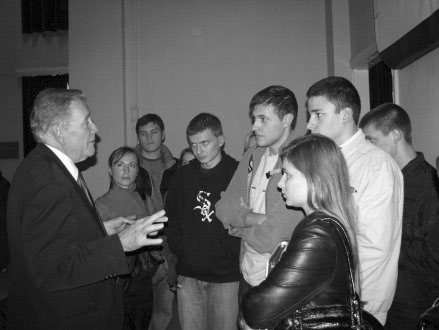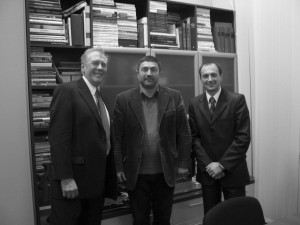Family Research Report – Aug/Sept 1998
 |
FAMILY
RESEARCH REPORT |
Journal of the
Family Research Institute
Founded 1982
|
|
Success in
Preventing AIDS? Not Really
|
Vol. 13 No. 4
Aug/Sept 1998
|
|
INSIDE
THIS ISSUE…
|

A tantalizing mix
of recent headlines
Corporate
America: Subaru,
the 4-wheel drive auto company, has issued a special deal for homosexuals
who have a Rainbow Card, an identity VISA credit card supporting the
gay movement. Subaru will donate $100 to the gay movement and give an
additional "45,000 miles of scheduled maintenance with your new
Subaru." British Airways similarly offered a special $50 discount
on a companion ticket in early 1998 to those who charged their ticket
on the Rainbow Card. What a world! Fifty years ago, homosexuality was
a criminal offense. Today, it’s an advantage!
New
York: High Times,
the pro-marijuana magazine, has fallen on low times. It had a circulation
of half a million in the mid-70’s, but has fallen to half that today
(Washington Times, 7/10/98).
Great
Britain: In June
the House of Commons voted almost 3:1 to lower the age of consent for
homosexual relations from 18 to 16. In July, the House of Lords voted
2:1 to keep it at 18. Gay activists demonstrated and derided the House
of Lords with shouts and jeers.
|
The headlines screamed, and even
National Public Radio crowed: even in the inner-city, AIDS can be prevented!
 Imagine,
Imagine,
for less than $300 apiece, inner-city Blacks and Hispanics can be "taught
to use condoms" and, as a consequence, not get AIDS. If true, a BIG DEAL.
But the reality does not match the rhetoric.
Here was the plan. Separate those
coming to STD clinics by sex into small groups of 5 to 15 persons. Ask each
person to attend 7 twice-weekly 90-to-120 minute sessions on AIDS prevention/risk
reduction. At these sessions, have the leaders and other group members pressure
participants to be safe, use condoms, use clean needles, etc. Let a control
group just go to a 1 hour session featuring an AIDS prevention videotape. Then,
over the next year, assess the participants in the study at the 3rd month, 6th
month, and 12th month for: 1) self-reported claims of condom-use in the 90 days
before the interview, 2) for men only, STDs as indicated on their chart at the
STD clinic, and 3) at the 12th month follow-up, tested prevalence of chlamydia
and gonorrhea via a urine sample.
About 1850 were involved in each
of the experimental and control groups. Whether participants were paid is not
clear, but the average number of "booster" sessions (called "dosex")
that the experimental group attended was 5.2, and 63% attended 6 or 7 sessions.
The results?
The experimental group claimed that
they were using condoms more often than the control group at each of the 3 assessments.
While statistically significant, the differences were not enormous. The average
number of "unprotected intercourse acts" claimed at the 12th month
assessment was 16.7 for the controls, 13.2 for the experimentals who attended
5 or fewer sessions, and 11.2 for those experimentals who attended 6 or 7 sessions.
The experimental group also claimed fewer symptoms that were suggestive of STDs.
If you can take people at their word
on these matters, a mild success. The objective measures, however, were not
good news for the investigators.
When it came to STDs as indexed by
the STD clinic charts, there was no difference between the experimental and
control groups about 9% in each case contracted an STD over the year. The investigators
did find that gonorrhea was a bit less common in the men in the experimental
group (1%) than in the control men (2%) on the STD charts. But the urine test
at the 12th month found no statistically significant differences between the
groups in gonorrhea or chlamydia.
So what we have is a fairly strong
study that generated weak or no findings. Just like the French study in 1991
that found no effect of public AIDS education upon STD rates (Family Research
Report, June-Sept, 1991), this study found at most a "hint" that a
fairly intensive small-group effort might actually reduce STDs.
While the authors argued that people
could be relied upon to "tell the truth" about their condom use, FRI
is skeptical. But if the authors were correct, then consider what they didn’t
find. In contrast to the small correlation reported between attending more booster
sessions and self-reported condom use, there was no report of any correlation
between self-reported condom-use and STDs.
Why not? Apparently there was no
such correlation. This non-finding punches a hole in the condom-theory of STD
prevention. You have to wonder whether the belief in the efficacy of condoms
is one of science or one of faith.
Reference: NIMH
Multisite HIV prevention trial group. The NIMH multisite HIV prevention trail:
reducing HIV sexual risk behavior. Science, 1998,280, 1889-94.
Just
How Effective are the Ex-Gay Ministries?
|
|
FRI is often asked about ex-gay ministries.
We generally give mildly-endorsing referrals to these efforts. After all, their
intentions are good. However, these organizations are not an unmixed blessing.
Consider some of the following facts:
 There
There
is no doubt that some who engage in homosexuality are converted or weaned
away from the lifestyle by these groups. This fact riles gay activists since
the bulk of them claim that they were born that way and can’t change. The existence
of those who have changed is a real ‘bug in the gay bonnet’ since it puts the
lie to one of their tactics. And it forces gay apologists to argue that those
who have changed weren’t really gay, or else they couldn’t have changed a rather
silly tautology that ignores the plain evidence.
Despite the living testimonials
of many ex-gays, there is little doubt that the cure rates among the ex-gay
organizations are nothing to brag about. All addictions, particularly sexual
addictions, are hard to break and many more people attempt to break away than
finally succeed. A great deal of time, effort, and money has to be expended
for each cure. Per dollar, the cure rate for sexual addictions is among the
worst of all the habitual sins.
Alcoholics Anonymous appears to have
popularized the ‘it takes one to save one’ slogan. Although this theme has influenced
many social workers over the past several decades, the evidence that it truly
works is not so clear. FRI has attempted to nail down proof that ex-druggies
do the best work converting druggies away from drugs, ex-drunks do the best
weaning alcoholics from alcohol, and ex-gays do the best converting homosexuals
away from homosexuality. So far, we have not found convincing evidence that
any of the Ex- programs run by Ex’s are more successful than programs manned
by non-professional non-Ex’s or those run by psychologists, social workers,
or psychiatrists. Either way, the success rate with addicts is not very high.
Because they tap into the ‘it takes
one to save one’ principle, the leaders of the ex-gay ministries don’t have
to have college degrees, and generally they don’t. The enthusiasm of the converted
is counted as good as or better than degrees. But perhaps formal learning doesn’t
make any difference when it comes to helping people. After all, many studies
that have compared the cure rates of students in psychology or psychiatry often
report as good or better cure rates for the students than Ph.D.s or M.D.s in
the field. Such heavy reliance upon enthusiasm, however, is troubling to those
that want reliable hard facts. After all, those who are not technically trained
will have difficulty evaluating the scientific literature on homosexuality (or
any other) topic. Enthusiasm is no substitute for the training that enables
critical evaluation of technical reports and scientific claims.
Everything Works Some of the Time
An important fact to remember when
evaluating the claims of any cure or program is that just about any treatment
or cure works for some people. In fact, FRI is unaware of any touted program,
from nude therapy to shock therapy and everything in between, that can’t claim
some successes and trot out some testimonials to prove it. There are always
some who testify that a given program did them some good or cured them.
The real issue then is not whether
some are helped, since some always are, but rather whether some reasonably predictable
proportion of those contacted by the Ex-program are cured. Further, how does
the proportion who are cured compare to the proportions cured by other programs
or simply by waiting until the person gets older (which works for most addictions
if the person doesn’t die first).
Usually, curative-minded groups or
treatments claim about a 1/3 success rate for those who stay the course of the
entire treatment. Of course, many addicts drop into Ex-groups for a look see.
Some will even try the program or treatment out for a while. But many, probably
even most, don’t stay the course. How do you count these people? If you consider
them failures, then the program looks worse. But it they are not counted at
all, that’s not quite fair either. Clearly, figuring cure rates for any given
Ex-program is exceptionally difficult.
Figuring cure rates is even more
difficult when the program or organization deliberately avoids collecting data.
Exodus, the largest Ex-gay consortium, does not collect any form of data on
cures or conversions. Instead, it collects data on number of books sold, number
of inquiries, number of attendees at conferences, etc. As with many social service
organizations, Exodus has no hard evidence that its approach works, other than
the usual set of testimonials.
In May we talked with a member of
the Exodus board of directors. He offered the usual social service line that
we don’t know how many were reached, but we know some are. And whether it’s
one or many, at least… We talked with leaders of another ex-gay group in June,
and they gave the same answer. This is somewhat frustrating, since there are
always people who would like funding under the guise of helping others. Prudence
dictates that programs demonstrate how much bang for the buck they deliver.
Unfortunately, like so many social service or helping programs, the ex-gay ministries
cannot provide that crucial information.
When government programs have been
carefully evaluated, they usually fail to accomplish much. So proof of efficacy
is both a legitimate and prudent request. When Bob Davies, North American director
of Exodus, was pinned by gay activists in mid-July, 1998 that two of the initial
leaders of Exodus had left their wives for homosexuality, he said "We don’t
claim to have 100 percent success. We know that there are many people that come
to Exodus who after a period of time realize that because of the difficulty
in the change process they lose heart and give up…that does not negate the
fact that there are many people who stick with it and experience significant
change." (Christian News 7/27/98)
As the example of Exodus suggests,
some of the leaders of the ex-gay movement appear to be still semi-entangled
with the lifestyle. As a consequence, a significant number of those in leadership
fall back into homosexuality, when, had they just quit, got away, stayed away,
and moved on, they might have escaped entirely.
It is a sad truth that those who
were once seriously involved with an addiction are more susceptible to the temptations
of that addiction than those who were never addicted to begin with. Public record
documents several cases of leaders of ex-alcoholic and ex-drug abuser programs
who ‘fell off the wagon.’ When those who are struggling with an addiction or
sin are around others who are so tempted, bad things can happen, and frequently
do.
For instance, imagine that you have
a large church. Adultery is a common problem. In a large congregation, it is
predictable that many are struggling with having committed adultery or being
sorely tempted to. Let us further imagine that you organize a program to help
such individuals. You announce that at such a time in such a room all those
who have committed adultery or desire to do so will meet together to comfort
each other, pray, read the Bible, listen to speeches from those who have overcome,
etc.
What will happen? Predictably, chaos.
Why?
Every man in the room will know that
every woman in the room either has or wants to commit adultery. Every woman
in the room will know that every man in the room either has or wants to commit
adultery. While some may be helped by this ministry, it is certain that the
program will also be a stimulus to pairing up adulterous individuals, serving
as a kind of introduction agency. By focusing a ministry on a particular sin
or problem, and bringing together those with that particular difficulty, significant
problems are almost guaranteed.
Consider this testimony from lesbian
Sandi Wiggins: "A little over ten years ago I was involved with two different
Ex-Gay ministries. I was involved to the point where I was a small group leader
and a hotline phone counselor. My thinking was completely change imperative.
I engaged Ex-Gay ministries because of my own deep cognitive and spiritual distress
about being a Christian and a lesbian. I met my partner at an Exodus conference.
About five years ago, I turned to yet a third Ex-gay ministry.
"Within the past two years,
I have been praying and brooding more intensely for resolution in my soul. I
had deeply internalized homophobia because of the way I understood that the
Bible and hence God thought about me. I totally believed that I could not live
a fulfilling life or be a Christian or be self-actualized unless my same gender
attractions disappeared.
"Now I have seen that all these
things are possible in my life and that I can truly continue to follow Jesus."
Notice the progression.
Sandi had "internalized homophobia."
That is, she felt bad about her involvement with homosexuality. But she DID
NOT WANT TO GIVE IT UP, so she hung around those with homosexual desires, ostensibly
to help them (and, FRI suspects, she genuinely wanted to help them quit). Still,
homosexuals were all around her. If she changed her mind again, the ‘right’
people were there to help her bail out and go back. Sandi hung around homosexuality
and homosexuals and eventually met her true [homosexual] love.
Jesus said that "If you love
me you will follow my commandments," including those commandments against
sexual immorality. Unfortunately, when asked to choose between sexual and/or
personal fulfillment and following Christ, people often choose the former and
reinterpret the latter.
If Ms. Wiggins had got free and moved
on, her life today might be very different. But now she is a cancer in both
the ex-gay movement and the church, arguing and proving by her very life that
one can claim to follow Jesus without actually doing so.
(To Be Continued in Next Issue)
 Regan
Regan
Wolf, 40, lives in Lancaster, SC, a state considering a "hate crimes"
law. To prove how badly hate-crime protection was needed she presented herself,
beaten and bleeding, to police. But, as with so many other "hate crimes,"
it was faked. It seems Wolf paid someone to beat her and then spray paint both
her and her double-wide mobile home with hate slogans such as "Jesus weren’t
born for you, faggot."
Wolf’s mother, lover and other gay
rights activists have used her as a poster-child, pointing to her beatings,
as proof of the need for such laws. Gay rights groups have called her a symbol
of persecution and rallied at the State House for hate laws. They also blasted
law enforcement officials for dragging their feet in the investigation.
The sheriff noted that thousands
of hours of police time had been spent on her case. FRI has also learned that
the Attorney General’s office is probably going to proceed against Wolf. South
Carolina has solid laws against perjury.
What a strange world. "Hate
crimes" are so attractive that homosexuals injure themselves and their
property to "prove" that they are hated by others and to get sympathetic
attention. FRI is unaware of any other kind of new law that tempts so many people
to become "victims" because of its existence. Even though maybe half
of the claims of rape are false or embellished, anti-rape laws have been around
for a long time. The newly-created hate crimes laws are spawning a brand new
class of fake victims.
(NY Times 7/17/98)
Title
IX Not Just for Women Anymore!
|
|
Title IX, a federal law that bars
"sex discrimination," protects gays! That’s the decision of the U.S.
Department of Education’s Office for Civil Rights (OCR). Under a ruling in Fayetteville,
AR, the OCR will "monitor the school system’s progress until June 1999."
Former Fayetteville student William Wagner, 17, and his parents active in Parents
and Friends of Lesbians and Gays brought the suit.
William, who was openly "gay,"
suffered "anti-Gay harassment throughout 1995 and 1996, when he was in
grades 8 to 10. Openly Gay, he was constantly jeered by students with epithets
like ‘fking faggot,’ was taunted about wanting sex with other boys and had drawings
passed around of him in sexual acts." In the 10th grade William was beat
up by some boys who were convicted of battery.
David Buckel of Lambda (an ACLU-like
organization for homosexuals), noted that since sexual orientation discrimination
in public schools is not barred by federal statute, the OCR had to be convinced
that the harassment William suffered was sexual. "Buckel notes that not
all anti-Gay discrimination and harassment in schools will constitute sexual
harassment under the federal statute. For example, he says, if students heckle
another student with anti-Gay comments but their actions or language do not
involve sexual conduct, those actions would not be sexual harassment. But other
abuse, as in the Wagner case, would constitute sexual harassment. For example,
Buckel says, if schools decide they don’t need to do anything about Gay-bashing
of boys because boys should settle their disputes off campus."
The Fayetteville school district
"agreed in the future to discipline students who sexually harass others;
monitor incidents of sexual discrimination and harassment; conduct training
for faculty and staff to deal with sexual harassment, including that directed
against Gay students; reiterate to students, faculty, and staff that sexual
harassment is prohibited; and hold an information and discussion session for
students on sexual harassment."
And the net result?
Hire more people to ‘re-educate the
educators.’
Perhaps they got off easy. After
all, the Ashland, WI school district had to pay another gay student $900,000
for his "torture" by fellow students.
(Freiberg, P. Washington
Blade, 6/26/98).
Why
Has Student Marijuana Use Gone Up?
|
|
Marijuana use increased in the 1970s
among the school-aged. It then decreased in the 1980s, but has has gone back
up in the 1990s. What’s happening?
Good data on reported pot use has
been collected on U.S. high school seniors each year from 1975 through 1996.
Each year a reasonably-representative sample of about 15,000 students was asked
about their use of pot, whether they disapproved of the use of pot, to what
degree they thought marijuana use was dangerous, and various lifestyle factors
such as how committed they were to their religion, what kinds of grades they
got, how many hours they worked at a job per week, and whether they recreated
away from their family.
As a rule, the more religious and
better students were less apt to use pot, while students who had more evenings
out per week or who were truant were more apt to use marijuana. But, all told,
these lifestyle kinds of variables only "explained" about 21% of the
variance in whether or not students smoked pot. Almost half (49%) of the variance,
however, in students’ smoking patterns came from what they claimed to believe
about whether marijuana was harmful and whether they claimed to believe that
it was wrong to smoke it. The correlations between beliefs and behavior strongly
suggest that when students believe that there is less risk in smoking and/or
believe that pot use is OK, then personal use is apt to rise. Not surprisingly,
the authors argue for more government programs to convince students that pot
use is bad and dangerous.
There is a problem, however.
That problem is that the voters of
America have been making pot easier to get. And why? Because marijuana is supposed
to be "good medicine" for certain folk. Compassionate use is now permitted,
by a vote of the people, in California and Arizona. Attempts are underway to
make compassionate use legal throughout the U.S.
Americans, especially teenagers,
think that "medicine" is a good thing. If teenagers are starting to
think about pot like they think about vitamins, there is going to be even more
of an upswing in pot use.
So this kind of magical thinking
could transform a "little pot" into a kind of "good thing,"
since some people are helped by a lot of it.
Will students believe government
slogans and ads, or the votes of their parents and neighbors? Time will tell,
of course, but something may be afoot here that can’t be fixed with public service
announcements on TV and radio.
Reference: Bachman,
J. G., Johnston, L.D., O’Malley, PM. Explaining recent increases in students’
marijuana use: impacts of perceived risks and disapproval, 1976 through 1996.
American Journal Public Health, 88, 887-892.

Corner
Just where is AIDS headed? Are things
as "in control" as the Centers for Disease Control claims? Two disquieting
things crossed my desk recently that suggest otherwise.
First, Paul D. Green of Minneapolis,
MN wrote FRI and the authorities in Minnesota that "I have been a medical
insurance billing clerk for over 10 years now… at 2 major Minneapolis hospitals
in the billing department…. my job was to bill various insurance and Medicaid
programs for the patients’ bills. I was very alarmed that I was seeing so many
cases of AIDS and other sexually transmitted diseases including Chlamydia, Herpes,
Syphilis and others in far larger number than were being reported on television
as the totals of these diseases in the State of Minnesota, and I was only one
billing clerk…." I talked with Mr. Green at some length and found him
credible. I checked with other physicians who assured me that STDs are so frequently
underreported that they would not doubt his story.
Second, Cary Savitch, M.D. has written
a book about AIDS, The Nutcracker is Already Dancing (1997), that is also troubling.
Through his experiences he has come to positions about AIDS control that FRI
has advocated since 1983. But the thing that strikes the reader is the sheer
volume of cases of HIV infection that he is getting in the relatively "backwater"
city of Santa Barbara, CA. There are "too many cases" for what one
would expect given its location.
It may be that "something is
going on" that isn’t reaching the official statistical summaries of the
epidemic.
 Family
Family
Research Report critically examines empirical data on families, sexual social
policy, AIDS, drug addiction, and homosexuality, digging behind the ‘headlines’
and breaking new scientific ground.
FRR
is published 8 times/year by the Family Research Institute.
Dr. Paul Cameron,
Publisher
Dr. Kirk Cameron,
Editor
Subscriptions: $25/yr
($40 foreign)
©1999
Family Research
Institute
P.O. Box 62640
Colorado Springs,
CO 80962-2640
(303) 681-3113
Return
to top








 Imagine,
Imagine, There
There Regan
Regan